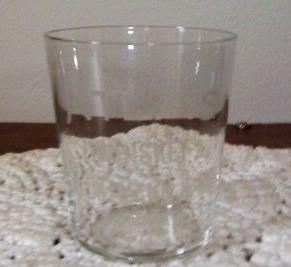
by Robin R Preston

Figure 1

Figure 2
Bottles and Extras, Vol. 17, Issue 2 (Spring 2006), pp. 26-29
 by Robin R Preston |
 Figure 1 |
 Figure 2 |
Shooting Shots: Part II
The Good, The Bad and The Ugly
The previous edition of Random Shots broached the subject of how to document
a shot collection photographically, beginning with a discussion of factors to consider when selecting a camera and stressing the need for a tripod
(see footnote at the end of this article for an update). In this issue,
I’d like to consider what makes a good photograph and then return with specific guidelines
in a subsequent installment.
eBay is an endlessly fascinating social phenomenon, but the sheer volume of
activity also means that it can serve as a powerful educational tool.
This is particularly true during winter months when 100+ pre-pro glasses are offered for sale each week. Every auction comes with at least one photograph, few of
which were created by professional photographers. Thus,
an investment of just a few minutes on the site rewards one with access
to images that vary widely in terms
of quality and diversity of technique and one quickly gains a sense of
what works photographically and what does not. The following pages present a
selection of these images and attempt to identify what makes and
breaks a shot-glass photo.
Shake, Rattle and Roll.
| The first example [Figure 3] reinforces the need to use a sturdy camera support when photographing glasses. This is a rare glass from Adolph Beck & Co. of Chicago, although it's difficult to ascertain its origins from the blurry photo. The human frame is simply not capable of becoming sufficiently rigid to support a camera without movement, meaning that hand-held photos are going to be blurred. The degradation in image quality may be subtle or, as in the example shown here, severe enough to make the label indistinct. |
 Figure 3 |
The myopic and presbyopic
The next few examples cover basic problems in technique that should
have been obvious in the camera viewfinder or digital view screen.
The first [see Figure 1] suggests that the photographer was peering at the glass through bottle lenses, because the shot was jammed right under the nose of the camera. The optics were unable to focus at such close distance so the resultant image is blurred. There are additional exacerbating issues such as a hand-held glass (more blur), most likely a hand-held camera (still more blur), and use of a flash (reflected hot-spots), all of which add insult to injury of the fact that this is a detailed and highly desirable glass from Jas. Gorman of Lynchburg, VA.
| Next is an image in which the subject occupies only a small fraction of the frame [Figure 4]. This kind of presentation is common in listings where a scanner has been used to create an image of a glass, or where a collection of five or six glasses are being auctioned as a group. Sellers seem to think that they have to stand several feet distant from a group in order to fit them all within the frame, paying little attention to whether or not the frame is actually filled, let alone whether or not potential buyers can ascertain condition of the glass or even distinguish a label. Since even the most basic image manipulation programs have cropping tools, it’s easy to clean up such photos, although cropping does nothing to aid resolution (photo editors come pre-installed on new computers but if yours did not, free downloads are readily available via the internet). |
 Figure 4 |
The lesson to be learned from the previous examples is that the glass needs to be
sufficiently close to the camera that the label and general condition can be
readily established, but not so close that it exceeds the minimum focusing
distance of the lens.